Cruise missile submarines P-6
Work on the P-6 project began in accordance with the Council of Ministers resolution of August 17 of 1956. The development of a new rocket was commissioned by OKB-52, headed by V.N. Chelomey. By this time, the design bureau had already been engaged in the project of the P-5 cruise missile. In the course of the new project it was planned to solve several new problems, with the help of which the military leadership was going to seriously increase the strike potential of submarines. First of all, it was necessary to create and install a homing head on the rocket, which made it possible to direct to a specific target, and not to the intended area of its location. In addition, some other innovations related to the tactics of application were planned.
A prospective missile system based on the P-6 rocket was supposed to become part of a large-scale search and destruction system for targets in the oceans. In addition to the submarines with missiles, this system was supposed to include spacecraft, patrol aircraft and other means of detecting surface and underwater targets. The P-6 rocket, in turn, was to be used as one of the main means of hitting detected targets.
Requirements for flight characteristics were formed taking into account the achieved success of the P-5 project. To simplify development and operation, it was decided to build a new P-6 rocket based on the P-5 being developed. This allowed to save on the creation of a new airframe and power plant, as well as to simplify the operation of weapons in the future. As a result, the two ready-made rockets had almost no external differences, and also received similar basic characteristics, except for the accuracy of hitting.
The basis of the new rocket was the already developed airframe, built according to the normal aerodynamic configuration. Its main element was a streamlined fuselage with an ogival head and tail nozzle of a cruising engine. In the central part of the fuselage, under the bottom, there was an air intake. From the P-5, the P-6 rocket "inherited" the mid-range swept wing. To reduce the size in the transport position, the rocket received folding wing consoles. In the transport position, they were lowered by turning down and fixed at the sides of the fuselage. Immediately after the release of the rocket from the launch canister, the wing had to be decomposed by a special machine gun. Interestingly, the development of the automatic layout of the wing turned out to be one of the most difficult design tasks: it took about five years to create. In the tail section of the P-6 rocket, it was proposed to retain several small ridges and rudders, as well as a keel with a rudder located under the fuselage. On the sides of the keel, it was planned to mount two starting solid-fuel engines.
The dimensions of the new product corresponded to the base rocket. The length of the P-6 was equal to 10,2 m, the case diameter reached 1 m. The wingspan in the unfolded position, as before, was 2,5 m. in the form of a warhead of the required type could weigh up to 4,5 kg.
The power plant of the P-6 rocket consisted of two drop-down starting engines assembled into a single unit and one sustainer. For the initial acceleration and lifting of the rocket into the air, it was proposed to use two powder accelerators with an 18,3 ton. The fuel supply was enough for 2 to work, after which the rocket, having picked up speed, could continue flying independently. The flight to the target was proposed to be made using a cruising jet engine KRD-26 with a 2250 kg. Parameters of the main engine and associated flight characteristics of the rocket depended on several factors: from atmospheric conditions to the characteristics of the flight task. For this reason, the maximum flight speed could reach 1650 km / h, and the maximum range was determined at the level of 650 km.
The new rocket could use two types of combat units. One of them had a high-cumulative effect, the second was a special ammunition. With its own weight not more than 1000 kg, the latter had a power 20 kt. The proposed combat units allowed to attack as a separate surface target, and the naval connection as a whole.
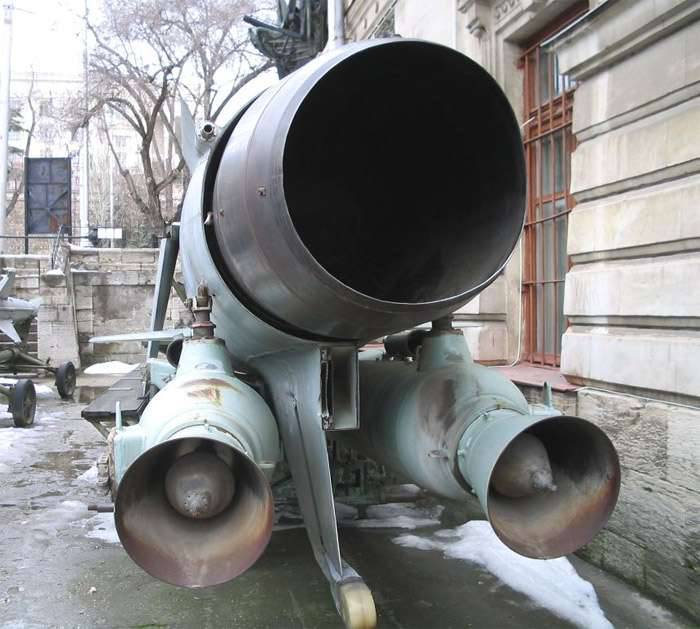
The tail of the rocket. At the top of the main engine nozzle, below - starting accelerators. Photo Militaryrussia.ru
Especially for the P-6 rocket, a new active radar homing head was developed, as well as a radio control system. During combat shooting, it was proposed to use both systems alternately, which could ensure maximum efficiency of shooting. The implementation of the original proposal concerning the use of various methods of controlling the rocket, later led to some complication of the control systems. In particular, it was later proposed to supplement the onboard assets of submarine carriers with systems of special airplanes and helicopters, with the help of which a significant increase in the radius of the missile system was achieved.
For the use of missiles P-6 submarine had to get its own radar search for targets. In the course of firing rockets, it was also used to monitor the flight of the rocket and the adjustment of its trajectory. Also, the submarine was supposed to have a radio communication system with a missile and a fire control station. To interact with such equipment carrier rocket had to have a two-way radio communication system, as well as active radar seeker and radio command control.
The original method of using the rocket was proposed. Immediately after the launch, the P-6 product with the help of the autopilot had to rise to an altitude up to 7 km, which ensured its confident tracking by the radar station of the carrier and the correct reception of control commands. Further, most of the route had to be overcome with the help of an autopilot holding a given course and operator commands. The task of the latter was tracking the rocket and adjusting its course. The control panel allowed to give commands to the rocket for turning left or right.
After approaching the target at a distance of about 40 km, the active radar head of the rocket was supposed to start tracking the situation and detect targets. Such information was not used by the rocket independently, but was transmitted to the operator’s console. When a single or group target was detected, the operator had to independently choose one of the found objects and give a command to attack him. After that, the missile seeker captured the target and independently guided it. After a target was captured, a rocket that no longer needed the operator’s commands could be reduced to a relatively small height and thus overcome the enemy’s defense systems.
In addition to the combined command and independent targeting, the P-6 rocket apparatus allowed to conduct attacks only with the use of GOS. In this case, in particular, the submarine could fire a volley of several missiles without the need to control their flight and target distribution. The specific mode of combat work was to be determined in accordance with actual tasks.
Being a further development of the P-5 rocket, the P-6 product received a similar launch canister. It was proposed to store and launch the rocket using a CM-49 container, which was a cylinder with an inner diameter of 1,65 m and a length of 12 m. A set of necessary connectors and rail guides for the movement of the rocket were provided inside the container. At both ends, the container was closed using two sealed covers with a seal. In order to avoid various problems in the transport position, it was proposed to fill the container with nitrogen. Before launching, the hydraulics of the submarine had to lift it into position with an elevation angle of 15 °.
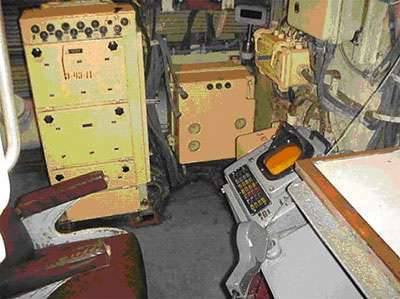
Combat post commander of the submarine used when firing missiles P-6. The screen displays information from the missile seeker. Photo Flot.com
The most important feature of the P-5 and P-6 projects was the maximum degree of unification. At the same time, however, not all P-5 submarines could quickly get the opportunity to use P-6 missiles. For new missiles required the appropriate equipment to search for targets and control missiles. In addition, after the start of testing and development of the P-6 rocket, another factor was identified that made it difficult to replace missiles quickly. As it turned out, products P-5 and P-6 received different connectors for connecting to the carrier systems. For re-equipment of containers of a submarine with installation of new connectors sometimes it took several days.
Despite the use of the finished airframe and spent power plant, the P-6 rocket passed all the necessary tests. So, at the end of December 1959 of the year at the stand of 4A under Balaclava, the first test launches started. Until July of the following year, five test launches of missiles without electronic equipment were carried out. Successful completion of these tests allowed to continue the work and begin to check the missiles in full configuration.
From July to December 1960, six missile launches from a fixed and swinging stand were carried out at the Nenoks site. In the course of these checks there were a large number of failures associated with the unsatisfactory performance of the rocket control equipment. The next year, 1961, was spent on revision of control systems and new tests. Until the end of 61, seven more launches were completed with satisfactory results. Most of the identified deficiencies were eliminated.
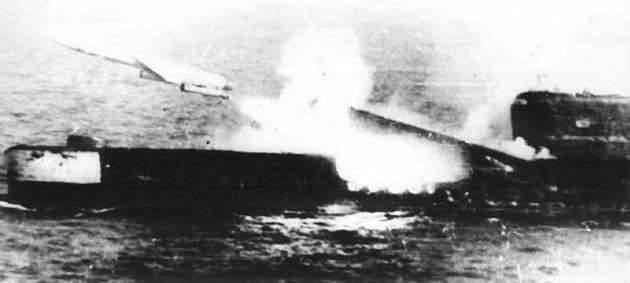
Launch of the P-5 rocket from the submarine of the 651 project. Photo Kollektsiya.ru
In May, 1962, at the same northern test site, began joint flight tests, which lasted until the end of the year. 13 launches were performed, of which 7 was successful. Interestingly, during this stage of testing, an event "Killer Whale" took place. At the end of July, the top leadership of the country were shown the launches of several newest cruise missiles, including П-5 and П-6. In particular, the P-6 rocket was able to successfully hit the decommissioned destroyer. After hitting the rocket, the ship broke into two parts and sank. N.S. Khrushchev, who was present at the event, approved the work of engineers and rocket engineers, but criticized the flooding of a large amount of scrap metal.
By the summer of 1963, the re-equipment of one of the 675 project's submarines according to the 675-U project was completed. The purpose of this work was the installation of new equipment necessary for the use of missiles P-6. According to reports, all improvements concerned only electronic equipment. Regular missile containers CM-49 received only new connectors. The converted submarine could carry eight cruise missiles in containers arranged in pairs in front of the felling fence and behind it (2 container in front, 6 - behind). Using different modes of operation of the systems, it was possible to fire a volley of four missiles.
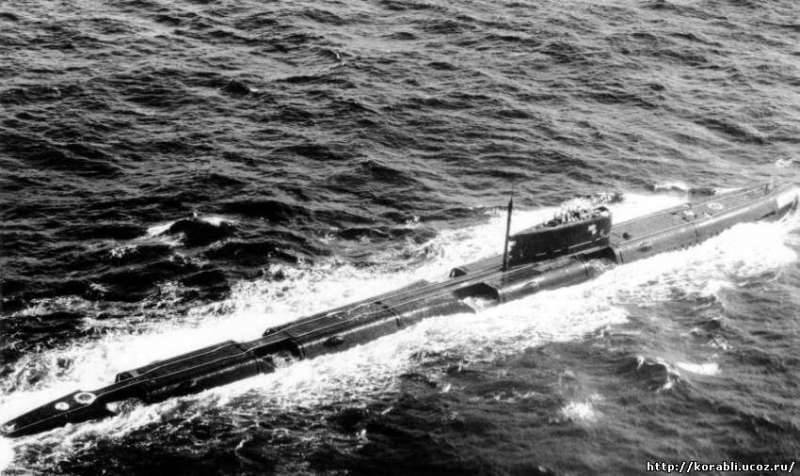
The submarine of the 675 project is representative of the most massive series of missiles, the P-5 and P-6. Photo Forums.airbase.ru
In July-October, the 1963, the only 675-U type boat, launched five launches of new missiles. Two start-ups led to a direct defeat of the target with its subsequent flooding. Tests recognized successful.
By the autumn of the same year, work was completed on the preparation for the third stage of joint tests. This time, the submarines of the 651 and 675 projects developed for the use of П-5 products were to be carriers of the missiles. After installing some new equipment, the combatant submarines were able to use P-6 missiles. The submarine of the 651 project completed three launches, and the 675 - nine. The first one successfully completed all the shooting, while two launches of the 675 project boat failed. By this time, a total of more than 45 P-6 missile test launches were completed.
The successful completion of all tests opened the way for the P-6 rocket to full-fledged operation and mass production. 23 June 1964 of the Year The Council of Ministers of the USSR decided to adopt the P-6 rocket into service with submarines. Soon after, the integration of such missiles into the armament complex of the existing submarines of the 651 and 675 projects began. For this, the submarines received some new equipment needed to find the target and control the rocket. One experienced submarine of the 6-U project with eight launchers, 675 submarines of the 16 project with four containers and 651 atomic submarines of the 29 project with eight missile ammunition could carry the P-675 missiles.
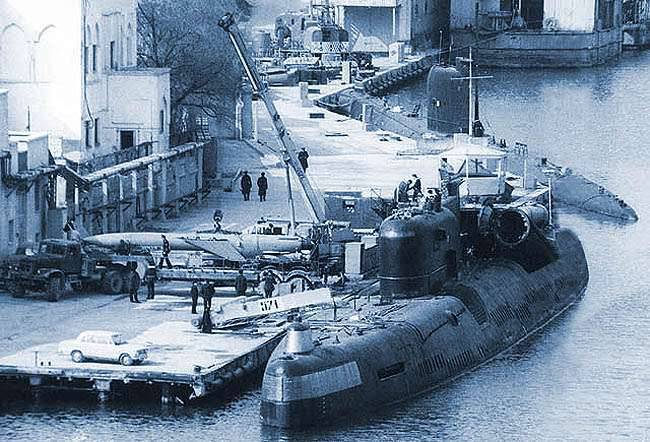
Loading a cruise missile in the 651 submarine stern containers. Photo Flot.com
Even during the tests, it was found that not all cases, the submarine carrier has a full-fledged ability to independently find the target and lead the missile to it. The low height of the submarine antennas limited the target detection range, and also reduced the maximum missile launch distance. For this reason, it was necessary to introduce repeaters into the complex of rocket controls in flight, ensuring reliable operation of the missile system at any range. Signals from the submarine and from the rocket were now proposed to “pass” through the equipment of the Tu-16РЦ and Tu-95РЦ aircraft or the Ka-25РЦ helicopter. This made it possible to carry out firing in a combined way (operator control and homing) in the entire available range of distances. The new MRST-1 signal relay system was put into service in 1965, seriously increasing the strike potential of P-6 missile boats.
Probably, after adopting the P-6 base missile, it was decided to continue the development of this project. There is information about the development of products P-6M and P-6D, but accurate data about them is missing. In addition, there is reason to doubt the very existence of these projects. For example, the only thing known about the P-6M rocket is that it was a modified and improved version of the original P-6. There is no list of changes.
The only known modification of the P-6 rocket is the converted missile target. Similar products were used to train the calculations of anti-aircraft complexes up to the nineties of the last century. The supersonic rocket, approaching the target at a height of about 100 m, was a rather complicated target for anti-aircraft systems.
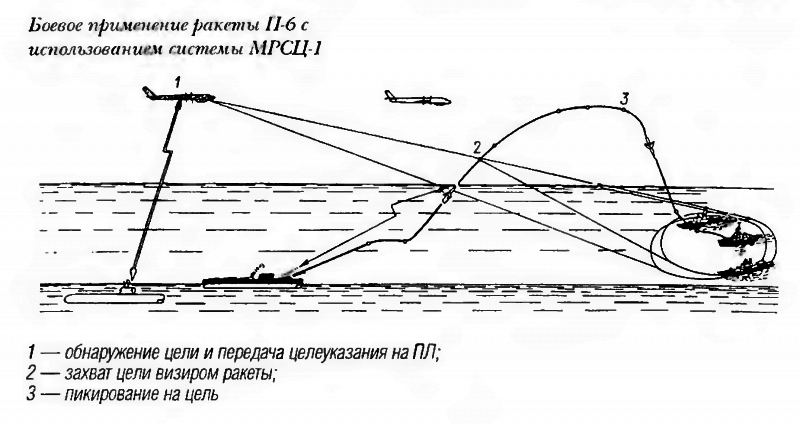
The use of P-6 missiles when using a repeater aircraft. Figure Shirokorad A.B. Weapon domestic fleet. 1945-2000.
The operation of the P-6 missiles, according to various sources, continued until the end of the sixties. After that, the fleet began to include new submarines with more sophisticated missile systems, differing in enhanced performance. For this reason, most of the carriers of the P-5 and P-6 missiles were eventually re-equipped for new missiles. However, as far as is known, the P-5 and P-6 missiles were used for a long time as targets for training anti-aircraft gunners.
Within the framework of the P-6 cruise missile project, for the first time in domestic practice and in the world, the problem of salvo firing was solved with the selective defeat of the formation ships designated by the targets. This made it possible to significantly increase the effectiveness of new missiles in comparison with existing P-5 due to the removal of weapons directly at the target, rather than in the specified area of their location. Taking into account the characteristics of missiles and air defense systems of that time, submarines with P-6 products could inflict serious damage to the conventional enemy naval connections.
It should be noted that the P-6 rocket differed from the P-5 not only in a positive sense. So, because of the new mode of guidance, the time during which the submarine carrier had to remain on the surface increased. When launching the P-5 missiles, the boat could prepare a weapon for several minutes and fire and then go under water. When using missiles, the P-6 should have remained for quite a long time, until the moment the target was captured, to remain on the surface without the possibility of going deeper. Nevertheless, the increase in combat effectiveness due to a cardinal increase in accuracy was considered an acceptable price for such shortcomings.
In parallel with the P-6 missile for submarines, OKB-52 developed a similar system for arming surface ships. The result of this project was the appearance of the complex with the P-35 rocket. This product was maximally unified with the P-6 and for a long time remained an important element of the surface fleet armament. Thus, the ideas embodied in the P-5 project were further developed and successfully continued in the form of several types of new missile weapons.
Based on:
http://rbase.new-factoria.ru/
http://testpilot.ru/
http://flot.com/
http://nevskii-bastion.ru/
http://militaryrussia.ru/blog/topic-391.html
Shirokorad A.B. Weapons of the domestic fleet. 1945-2000. - Minsk: “Harvest”, 2001
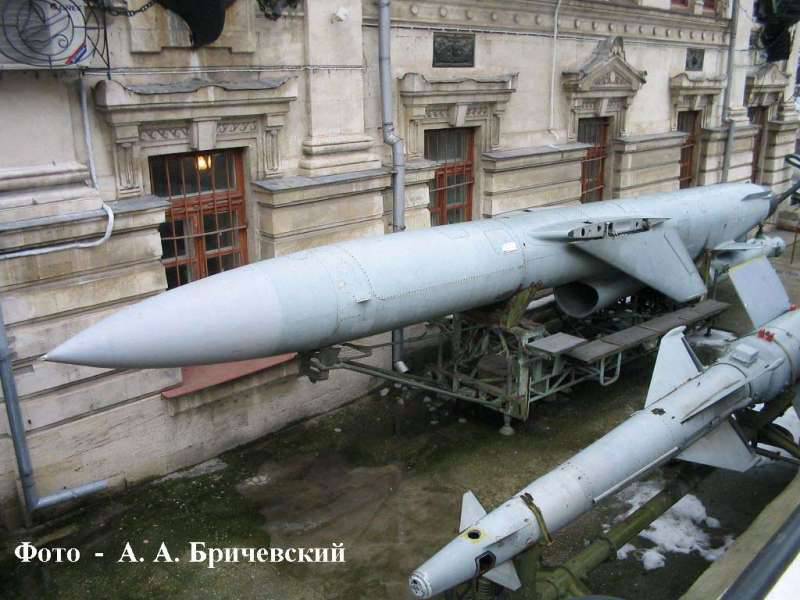
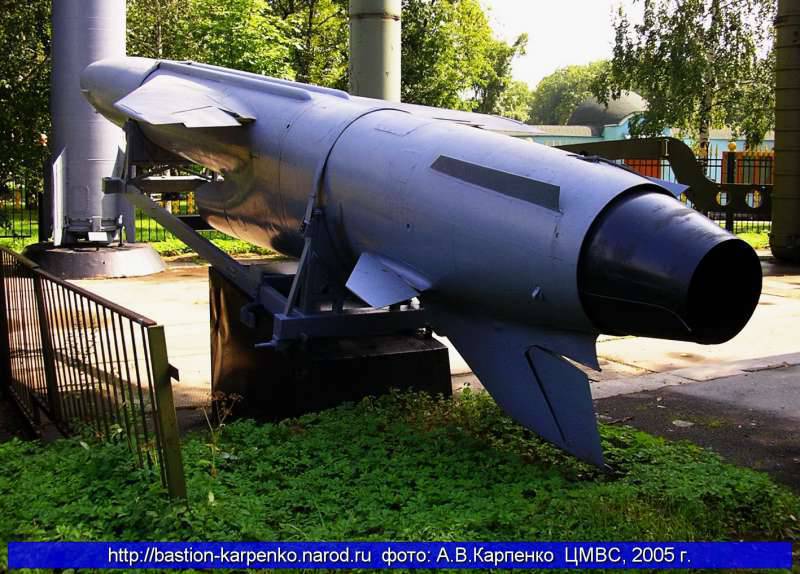
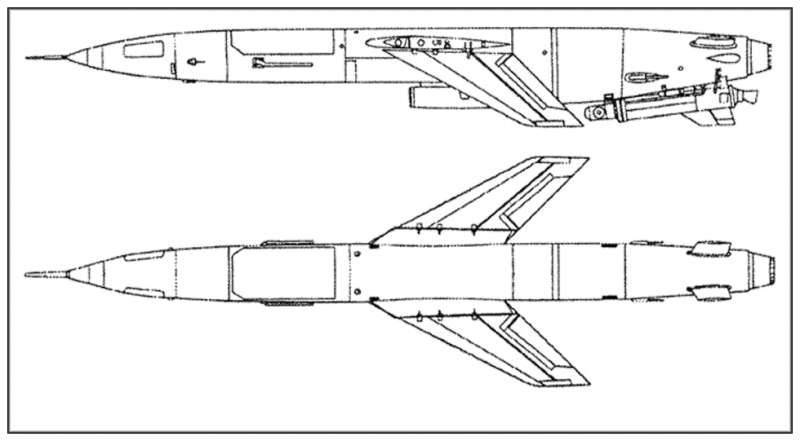
Information